Why relying on motivation is ineffective
Similar to emotions, motivation dwindles. It comes and goes. Much like the wind, you can experience a powerful gust of motivation that will set you on a path to overcome pee shyness only for motivation to then fade, making you abandon the behaviour it influenced you to engage in.
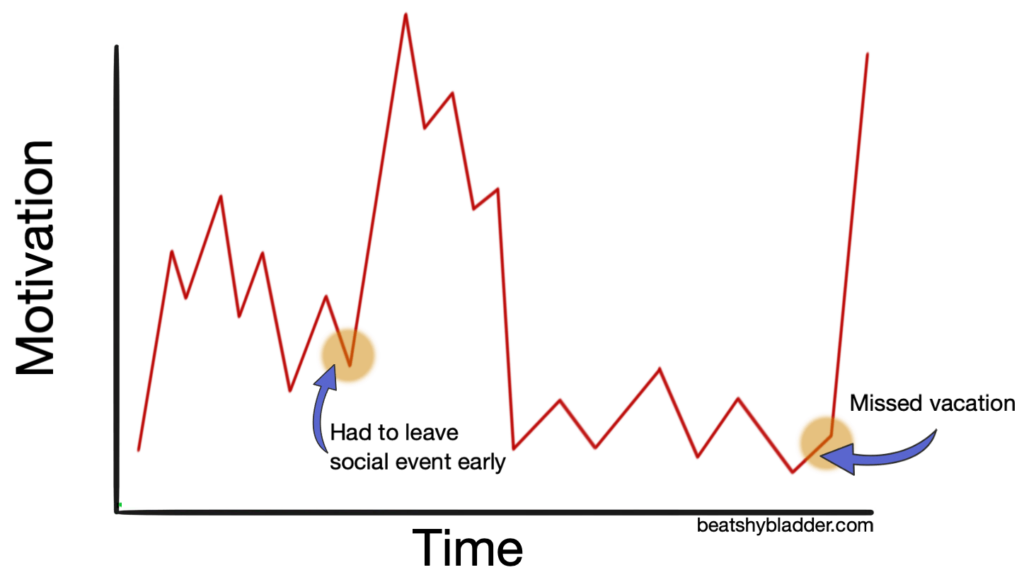
Often times, after having a troubling experience with pee shyness, people will be very motivated to practice exposure therapy (or another protocol) to make improvements. However, as the days go by and the motivation fades, the lack of immediate results will have these people go back to their old ways.
In order for meaningful, long term improvements to be made, you ideally want to working on overcoming pee shyness on a daily basis. You see, success is the product of daily actions.
Like developing any other skill or belief, this game is won through the aggregation of marginal gains. Accumulating incremental improvements every day will transform you into a whole new ‘you’.

It’s the lag time between cause and effect that makes people give into bad habits and quit good habits. If you study French tonight, you won’t be fluent tomorrow. If you workout today, you won’t win a bodybuilding competition tomorrow. Conversely, if you eat bad food today, the needle on the scale won’t move much. This is why people quit good habits and embrace bad ones. Single decisions are easy to dismiss as unimportant (don’t fall for this trap!!).
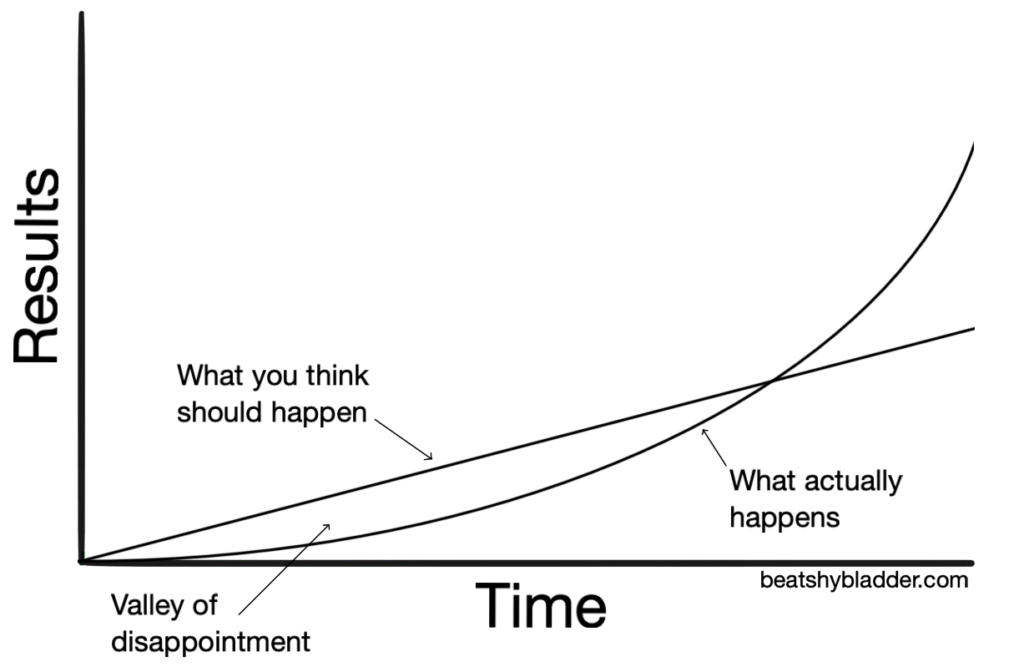
Furthermore, we often expect progress to be linear. In reality, we often find that good habits and behaviour compound over time. This can cause people to quit sticking to their plan of action prematurely as they experience the ‘valley of disappointment’.
A slight shift in a planes direction completely changes the destination. Likewise, making slight habit changes will take your life to a whole different destination because actions are compounded over time. Small incremental improvements to our routines can lead to massive changes and improvements in our lives.

What does this mean for overcoming shy bladder syndrome? Developing good habits that lead to small, daily incremental gains will help you to, over time, confidently void in crowded spaces.

In essence, you get what you repeat. If you repeatedly engage in your coping mechanisms (more about coping mechanisms in this blog), you will only exacerbate your paruresis. Conversely, if you consistently follow your plan, big improvements will be incoming.
How you can develop good habits to overcome a shy bladder
Create a plan
Having and following a plan is critical.
Planning the when and where of the necessary actions will drastically increase the likelihood of you performing them. If we just say, ‘Ill eat healthier’ or ‘I’ll meditate’ but don’t pinpoint how, when and where, we are leaving it up to chance which is not a very good strategy.
With a plan, the element of chance is removed. Make sure your plan incorporates statements like ‘I will…<activity>…for/at …<time>… in …<location>…’
Here are a few examples which can help you form a plan to help you overcome a bashful bladder:
- After I close my laptop at night, I will meditate for 2 minutes in my room.
- When I feel the urge to void, I will box-breathe for 60 seconds on the spot and head over to the nearest available restroom.
- When experiencing a misfire (this is when shy bladder kicks in), I will stay put and focus on my breath for 2 minutes before leaving (you can incrementally increase the time to 3 minutes, 4 minutes etc.)
- On my lunch break every day, I will go to the local mall and attempt to void for 3 minutes before finding a ‘safe’ restroom (again, you can increase the time as you become more confident)
Make sure your plan works for you and your daily responsibilities. Feel free to include elements of meditation, visualisation, exposure therapy, neurofeedback etc.
Track your daily activities
It can be easy to create a plan and then forget about it. By tracking your daily activities, you can stay motivated and spot patterns you may not have been aware of before (e.g. you may find you have a natural tendency to become complacent after 5 days of good work) and course-correct accordingly.
Writing down your efforts at the end of the day can also give you a sense of accomplishment and motivation which you can carry over onto the next day.
Here is an example of what a simple tracking sheet might look like. Make sure you leave your tracker out in plain site so it is easily accessible and your likelihood of actually filling it out increases.
| Day | Summary |
| Tuesday, June 6th | Mediated for 5 minutes in the morning Exposure therapy on lunch break |
| Wednesday, June 7th | 5 minute visualisation after lunch Desensitisation session with my trusted buddy |
Start a 30-day challenge
How long does it take to form a habit? Different sources will provide varying answers. These mostly vary from 21 days to 200 days1. Either way, the more repetitions and consistency under our belts, the easier it will be to stick to the plan.
Undoubtedly, the first few days will be the hardest, but if we are able to stick to our plan every day for 30 days straight, the level of automaticity will have greatly increased, making the process feel a lot more automatic.
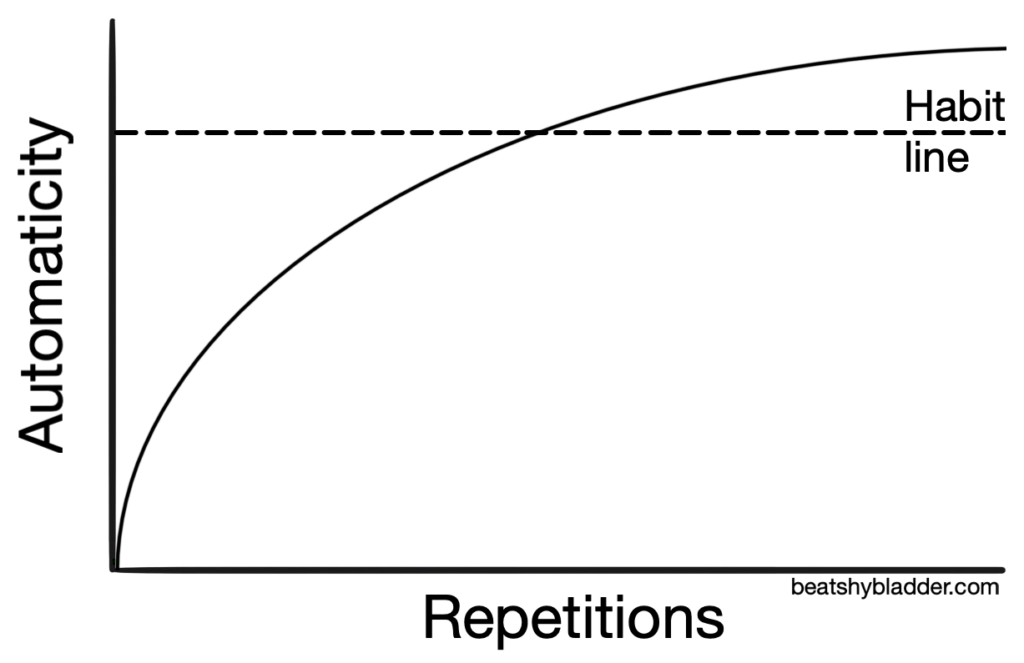
Start off easy, even 5 minutes of dedicated time to overcoming pee shyness on a daily basis is much better than nothing at all!
Remember that all streaks end at some point. We need a plan for getting back on track if we do slip up. Try your best to never miss two days in a row. The first mistake isn’t what destroys you, its the second one because that’s when a new pattern starts to form. Too often we adopt an all or nothing attitude with habits. The problem is not slipping up, the problem is thinking that if you can’t do it perfectly that you shouldn’t do it at all.
Awareness
Before we can start building new habits to replace our current ones, we need to become aware of our existing habits. As Karl Jung said, ‘until you make the unconscious conscious, it will direct your life and you will call it fate’.
A cool little hack we can use to help us make good decisions is to say the action and consequence of something out loud. This helps to bring awareness of the consequences to the top of our mind.
For example, when you are in a public setting and you feel the urge to void, say ‘Im tempted to hold it in instead of attempting to void. This will help me avoid an awkward encounter but will reinforce the shy bladder condition and make it much worse for me in the future’.
Saying this out loud makes the consequence seem more real and ads weight to the action.
Upgrading your identity
In order to integrate a certain behavior into your day to day life, you must become the person whom the behaviour is a part of their identity.
For instance, when a person who has recently quit smoking is offered a cigarette, there are two answers they could respond with: ‘no thanks, I’m trying to quit ‘ and ‘no thanks, I’m not a smoker’.
It makes me cringe when I read comments on the internet about people saying things along the lines of:
❌ ‘I have a shy bladder’
❌ ‘I can’t urinate in public spaces’
Aaaaaaaghhhh, staaaawwp it!!! You are only conditioning yourself to act in alignment with the very belief you are reinforcing.
Reframe these statement to:
✅ ‘I can become increasingly confident in restroom environments’
✅ ‘Assuming I feel comfortable enough, I can void anywhere!’
✅ ‘With daily practice, I can build up my comfort in public spaces’
Here’s a pretty cool quote a heard somewhere: “What you think is what you say, what you say is what you do, and what you do is what you become” – Unknown
Reframing challenges as opportunities
Your perspective on something makes a massive difference in the way you approach it. Don’t say things like ‘I have to…’ and instead say ‘I get to…’. This frames actions as opportunities instead of burdens. Frame them in terms of their benefits rather than their drawbacks.
Make the habit enticing
There are many hormones and physiological processes associated with habit formation. Dopamine is one of them. Experiments show that without dopamine, we can still experience pleasure, but desire dies.
Conversely, when flooded with dopamine, we perform actions at breakneck speed. E.g. scrolling social media for hours without end of spinning the slot machine 600 times per hour.
Habits are a dopamine driven feedback loop. Dopamine is released not only when you experience pleasure but also when you anticipate it. It is the anticipation of a reward that gets us to take action. E.g. cocaine addicts experience dopamine spikes simply by seeing cocaine.
We need to make our habits attractive because it is the expectation of a rewarding experience that gets us to act in the first place.
A behaviour is much more attractive if you get to do one of your favourite things at the same time. E.g. having to pedal a stationary bike to power Netflix. This is called temptation bundling. Condition yourself to do something by getting to do something you enjoy along the way.
Think about the things you enjoy and how you could use them to make the habits more enticing. Could you start chewing your favourite gum when on way to restroom?
Goals versus habits: Which to focus on?
Having a goal such as ‘I want to be able to successfully void in <insert scenario> by <insert time interval>’ is great to have as a north star to aim for however, it is more productive to have your day to day focus be on adopting the right behaviour as opposed to the right outcome.
Furthermore, by focusing too much on the outcome, it can be easy to become frustrated when experiencing a misfire. On the other hand, by focusing on making the desired behaviour a part of you and your daily routine, you can call a day a success and feel good about it if you have stuck to your plan despite experiencing a misfire.
And remember, you do not rise to the level of your goals. You fall to the level of your systems. It’s remarkable hiw much progress you can make if you just don’t stop.
Overcome Shy Bladder Syndrome Today
Get your hands on the time tested Beat Shy Bladder Blueprint
- Self Auditing
- Protocol Reviews
- Knowledge Trove
- Feedback Loops
- Heart Rate Variability
- Visualisation
- Mindset Upgrade
- Desensitisation
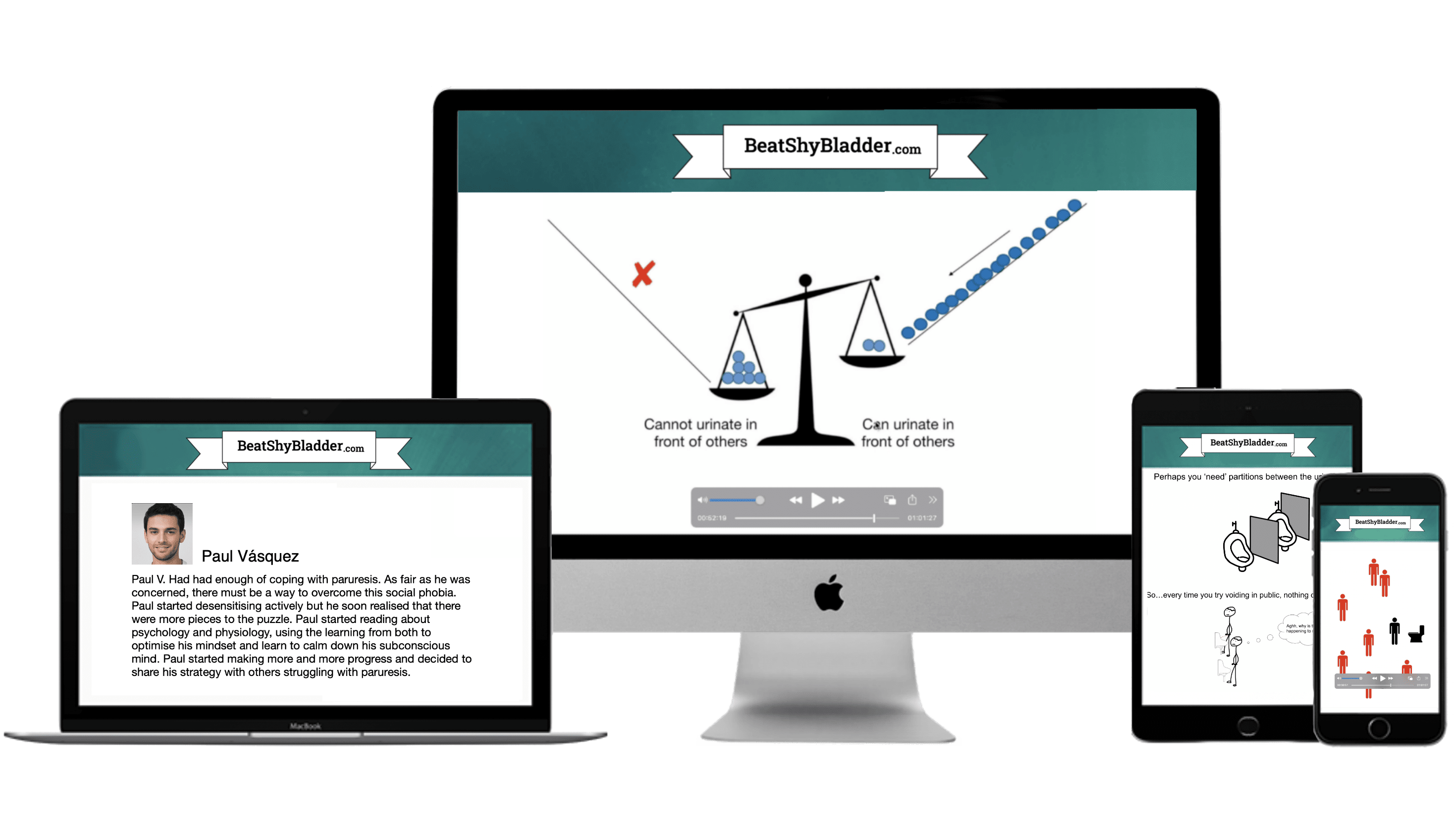
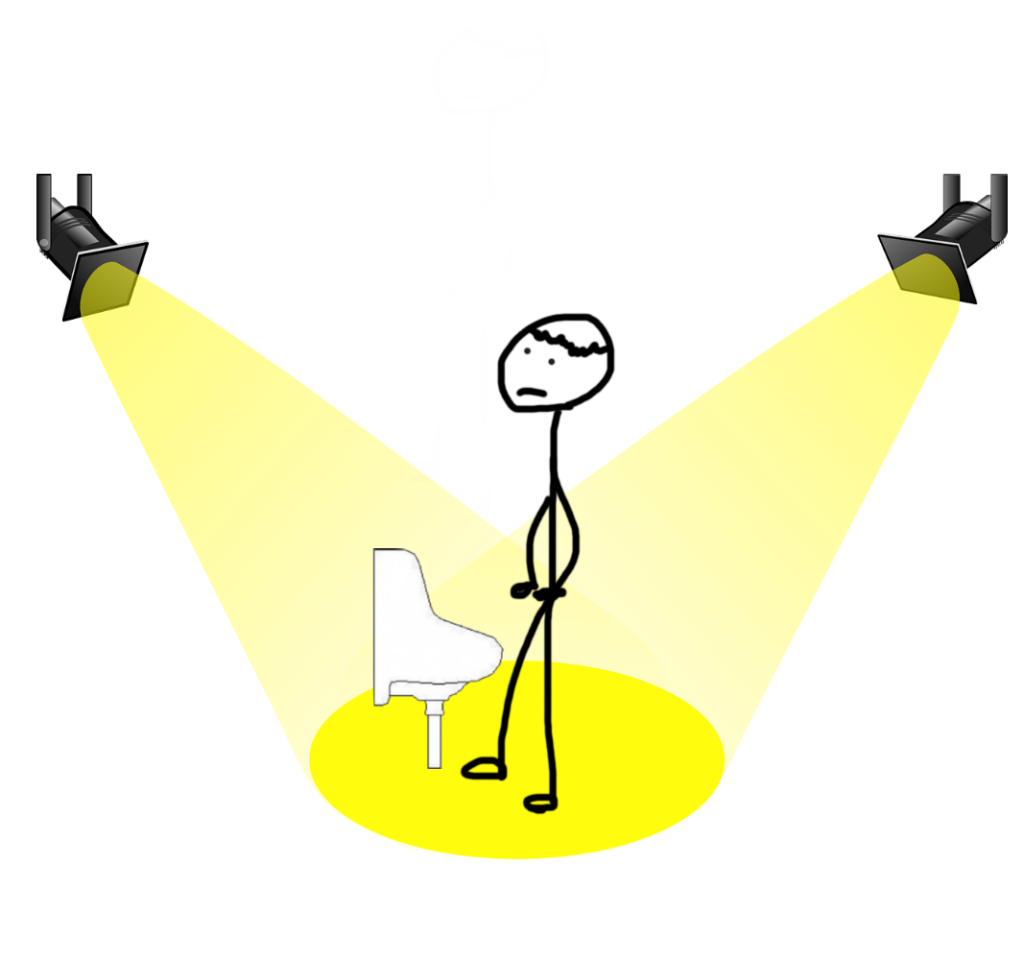

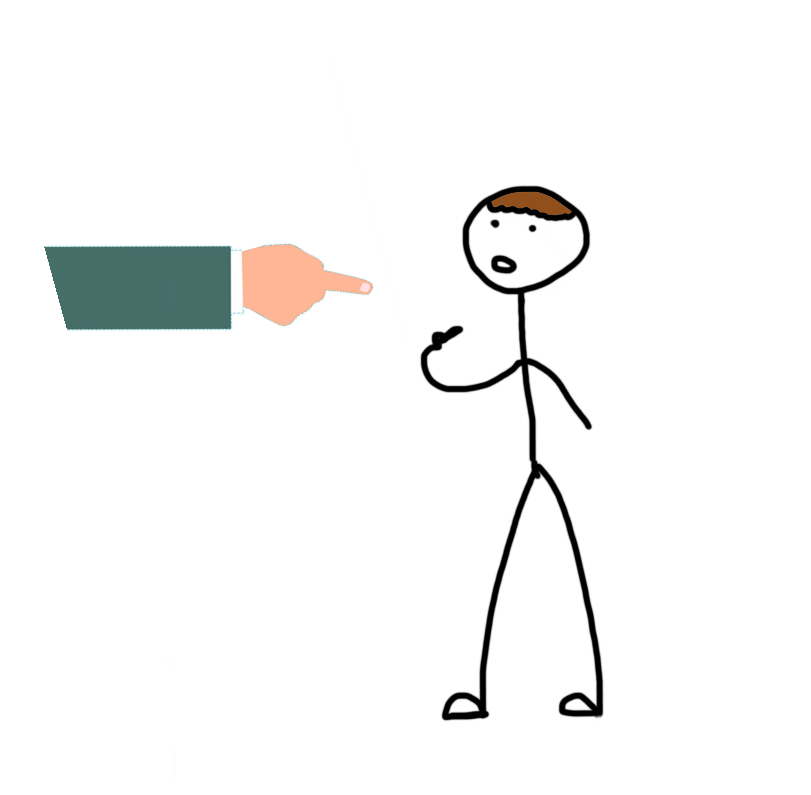

Is this true? It seems to me that something is very wrong here.
Hello Abe,
Disagreements and discussions are more than welcome. Which section of the blog post are you not sure about?
Most of this blog post is based upon James Clear’s Atomic Habits which has an astounding reputation for being a leading guide on habit formation.
Have a great day